Welcome to the Monday Roundup, where we’ve gathered (with help from readers) the most interesting stories and links from the past week…
Nabbing unsafe passers: Police in Birmingham (UK) are riding bikes undercover-style to catch people who pass them too closely.
Chicago #1 Bike City: Bicycling Magazine’s new rankings are out and Chicago has earned the top spot. The magazine’s editors felt it was Chicago’s turn at the top in large part because of their progress on physically protected bike lanes. San Francisco is ranked second and Portland came in third.
Speaking of protected bike lanes: The NYC Dept. of Transportation has been under fire from advocates for not doing enough to make streets safe for bike riders, so they’re doing a media push to tout their record-setting pace of building 18-miles of protected bike lanes this year.
They got the wrong guy: A man who was biking in Brooklyn says he was assaulted physically and verbally (with a racial slur) by two people inside a car — but somehow he’s the one who spent the night in jail.
Carbon tax goes mainstream: The time to start taxing people for how much carbon their vehicles emit has come, says the Washington Post Editorial Board.
Better blocks everywhere: Portland isn’t the only city where tactical urbanism — when citizens create temporary road re-designs — is taking off. NPR profiles the national trend with an eye on Burlington, Vermont.
No auto parking, no problem: Another local trend that’s happening nationwide is developers who opt out of including auto parking in housing projects.
Advertisement
Trebon retires: Professional racer and Portland resident Ryan Trebon has decided to retire from cyclocross and he gave an exit interview to VeloNews.
Backstreets and bike lanes are not a solution: We are in a post-bike-lane-only era — at least we should be. Curbed has a strong call for continuous protected bikeways on major streets as the solution to get more people riding more safely.
Unified strategy for a happy city: Copenhagen is once again showing the rest of the world how it’s done. This article in the Guardian details how officials break down government silos to create a comprehensive plan for citywide public health and happiness. If Portland attempted this, the public process would likely last for decades.
Good news in northeast: A 34-unit development on NE Killingsworth and 17th has been opened with help from a transit-oriented development grant from Metro.
Perspective is everything: Brooklyn Spoke expertly breaks down a weak answer from New York City’s mayor about people who park in bike lanes.
Fast e-bikes and the future: Yes, e-bikes can help people make the switch from driving to bike on long commutes; but at some point they are more akin to mopeds than bicycles and cities are starting to regulate them as such.
Our tweet of the week comes from author and Vision Zero expert Neil Arason:
If the car were invented today, given what we now know, it would be unconscionable and unethical to approve it as a consumer product
— Neil Arason (he/him) (@neilarason) September 17, 2016
— Jonathan Maus, (503) 706-8804 – jonathan@bikeportland.org
BikePortland is supported by the community (that means you!). Please become a subscriber or make a donation today.

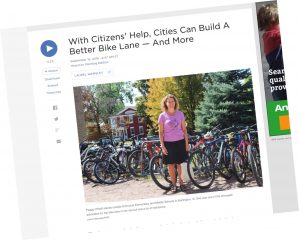
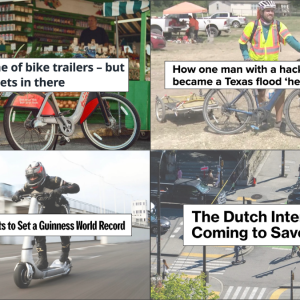
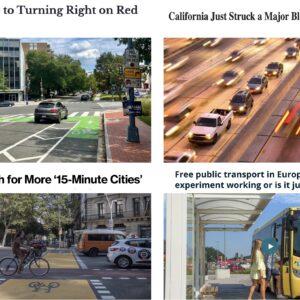
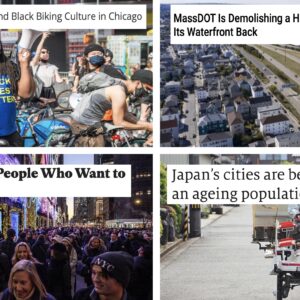
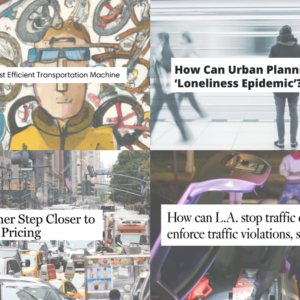
Thanks for reading.
BikePortland has served this community with independent community journalism since 2005. We rely on subscriptions from readers like you to survive. Your financial support is vital in keeping this valuable resource alive and well.
Please subscribe today to strengthen and expand our work.
cops on bikes nabbing scofflaw motorists – see why can’t we do that here in Portland? I suspect it would be cheaper to have cops on bikes than cops on or in most anything else.
What we lack is creativity, not money.
their first response would be that they don’t have enough officers to cover existing assignments and shifts. there is an extreme shortage of officers in portland and that fact impacts every one of these decisions. now add the new thinking about enforcement’s tie to racial profiling and you can see that there would be a lack of urgency in this type of program in portland.
Well when a cop came to talk to our neighborhood association about the foot and bike patrols they were then doing on Hawthorne to ‘build support for the Police’ and we asked him a bunch of follow up questions we learned that cops outside of cars were much cheaper and a better bang for the public buck. So if it really is money (and I get that staff is short) then how about being creative with the money and staff they do have.
I guess I find the endless and reflexive whining about money in our city, our school system, our state, to be a real drag, and most likely those predictable statements are 80% obfuscation. Most of the world’s municipalities probably have less money than our police or transportation divisions or schools, and yet they manage to accomplish some useful things we tell ourselves we can’t afford….
As for (a) shortage of officers, and (b) a black eye when it comes to racial profiling, I wonder if those two just might be linked?
I know I would rather contemplate working for an agency, a company, a group that didn’t have the racist reputation that our police (generally in this country) have brought upon themselves. I guess this to me all looks solvable, as long as those in charge don’t mind looking in the mirror now and then.
Fraternal Order of Police endorses Trump, who, unlike Clinton’s repeated discussion of the need for reform within the police culture, has made it his habit to reflexively side with the police no matter the complexities of the matter at hand.
Clearly there is so much introspection going on within the FOP.
I don’t accept there is an extreme shortage of officers. We have a shortage of housing, mental health workers, social workers, employment, and educational opportunities. Move drug and ‘livability’ crimes to human services, increase automated speed and red light cameras combined with infrastructure modernization and judicial Reform for automobile crimes so more irresponsible drivers have their licenses revoked ….then we would not need to replace all the open/ soon to retire positions.
If there is one thing the Trump candidacy has reminded me of is that we do not need to increase the size of the police state! We need to rethink who does what task in Policing society.
thanks for that perspective Terry.
Citizens/contractors with cameras on bikes and some desk staff to review cases would eliminate some chance of profiling or armed conflict, especially if the registered owner is liable rather than needing a clear shot of the driver’s face. I’m seeing a lot of photo-resistant plate covers, but there’s a web form somewhere to report those, right?
“their first response would be that they don’t have enough officers to cover existing assignments and shifts. …” maus
Portland already has bike cops. Beaverton does too. Ask the police departments if they dept couldn’t assign their bike cops a few shifts a week doing undercover cyclist traffic patrol. It’s interesting to think about how they’d do the operation in order to keep their undercover officer from being recognized as a cop. Probably, the UC guy would have to call a standby officer to come by and issue the citation.
The BAC tried to get PPB to implement a program like this about 20 years ago. That effort went nowhere.
Bike riding cops are extremely limited in what they can do and the equipment they have at their disposal, but could nab red light runners and distracted drivers in the central city with ease.
They might need a rack and panniers rather than a tiny seat bag with a CO2 canister in it? Add a 3kW motor + battery, tires a couple inches bigger than 23mm, full suspension and we would still be hundreds of pounds, hp, and tens of thousands of dollars south of a motorcycle with at least 40mph top speed and the ability to move one block in any direction in about 6 seconds. It would need to be licensed, have lights+siren, and officers might want some armor similar to their motorcycle kit, but something between foot patrol and motorcycle cop would be good right now.
They could stop drivers as they roll up to intersections on their phones. You can even do that on foot.
I agree with the quote from Neil at the bottom of the post. Just look at todays article on Oregon Live about the automobile carnage that took place over the weekend in Western Oregon. We tend to focus just on the Deaths caused by automobiles to vulnerable road users and ignore the even greater carnage caused by automobile drivers to each other, truly horrifying.
Humans were not meant to move so fast under their own control. Our senses and reaction times are insufficient and our bodies are not designed to handle the forces of the inevitable impact.
Just give us a few more generations and we’ll all look like Graham, the car-crash adapted human. As a population, we’re already adopting his overall round shape.
I got to see a presentation about what Burlington is doing in terms of Tactical Urbanism last week at the Pro Walk/Pro Bike/Pro Place conference. It was inspiring and so amazing to see how productive things can be when everyone comes together.
I also got to hear about A LOT of communities who’s cities have no interest whatsoever in making changes that way. And people were asking a million and one questions about how we at Better Block PDX have gotten so much done.
I think we are at a point right now where we are leading the movement, even though we here can find a million valid things to complain about. I’m excited to see where the tactical urbanism thing goes across the US and world because it’s booming right now and people are at a point where we need to take advantage of the momentum!
Remember, if you are ever interested in helping out with our Better Block PDX projects, email betterblockpdx@gmail.com and let us know!!
-Gwen
Weren’t we just talking about fault assignment in situations like this, here?
“We needed to do something about driver behaviour,” he said. “In about 98% of cases [the collision] was down to driver action, it was nothing to do with the cyclist.”
(From the first link in the Roundup above.)
I agree with the e-bike article. I think e-bikes are great and need to be encouraged as anything that gets people out of their gas guzzling death machines is welcome. But as they get more common and faster I think that it is inevitable that they will need to be classified more like a moped than as a bike.
I think 20mph is a good line in the sand. If you are consistently going above 20mph, a helmet and license should be required.
e-bikes in the suburbs — not a problem at all because the bike lanes are so scarcely used. e-bikes in rush hour downtown — need to turn down the power settings and act more like a normal bike. This isn’t rocket science. Different rules for different contexts. IMO — maybe we should allow (electric) scooters/mopeds in bike lanes as long as they don’t pass other vehicles in suburban contexts — we should be trying to reduce vehicle use overall.
I’m sure this will not be the consensus but I think that increasing the use of bike lanes in the suburbs by any types of vehicles will help reduce the backlash for building them
i consistently ride above 20 mph on my human powered bikes. should i be required to wear a helmet and carry a license?
Soren,
Your risk of death at 20 mph is just over 10%. At 25 mph your risk of death is 30% (Wramborg, 2005, from OECD).
Have you no dependents?
Cat 6 champion.
Unfortunately (in my opinion) 20mph already seems to be the cutoff for e-bikes in the US. I believe that’s too fast for a lot of bike lanes and bike paths. I’d prefer the cutoff to be somewhere in the 15-17 mph range.
Power vs weight becomes a big deal on inclines over 2-3%. 250W hub motor (a $600-700 conversion adding 8lb) will do 17mph with help on flat ground, but needs a lot of help to get 250lb of bike+rider up a 10-12% grade at 4-5mph. Even 1000W (max in oregon) mid drive will only get a cargo bike with kids to 10-12mph up some steep climbs (and 30mph takes a while to reach if you even have the gearing.) Mopeds generally start slightly above that ~1hp level, but the Dutch problem is that everywhere is flat. They probably need to start making moped/volomobile lanes, where what we need to do is remember that sidewalks are not real bike infrastructure and bikes can go faster than 20 mph, even uphill.
Recently saw hundreds of e-bikes in Europe, even higher end mountain bikes on trails with E-assist. Good luck getting over about 15 Km/hour on a European urbane bike path.
It has a motor and pedals, it’s a moped. Needs license, and above all, liability insurance.
Get back to me when everyone driving a car has insurance.
As well as a valid license indicating adequate training, not the namecard free for all we have going on now.
Eric,
Complain to me about the people that govern when everyone votes.
Current Oregon law specifically states that electric assist bikes limited to 20mph (and/or 1000w of output) are not mopeds and do not require licensing.
No, that would be terrible to classify as a moped. In Oregon, I would then have to get a car, so I can take a driving test then test for a moped endorsement. Just to ride a bicycle. You know what happens then… I will just drive, might as well, I can get a car for less then $2000 and most e-bikes start that much.
It would be nice if motorcycles with pedal assist were governed to 15.5 mph (25kph) here in the USA when used on multi use paths and bicycle lanes. I’m guessing 15.5 is probably the average speed for human powered bicycle transport. 28mph is clearly moped territory and should not be allowed on non-motorized routes.
Based on human nature and history I imagine we will see faster and more powerful motorcycles with pedal assist as they become more popular. Just like automobile manufacturers advertise and sell cars by increasing horsepower, so called e-bike companies are sure to follow suit by increasing the wattage of motors and adding larger battery packs.
I’m so pleased to see so many new riders on e-bikes. Almost all of them keep the speeds down to appropriate levels on bike paths; they probably have better compliance with basic speed law than pedal-only bikes. I fear that knocking back their max speed below 20 mph would kill off this growing segment of car-free travel.
Let’s not let the perfect, pedal cycles, be the enemy of the very, very good (getting people out of their cars and onto any bike, including e-bikes). Even a derriere chapeau on an e-bike who goes too fast for conditions isn’t likely to cause serious harm, as opposed to that same person driving his car.
By the way, I don’t own an e-bike. I did ride a couple of them for a local retailer to help them learn what range their products have. I had a good time and will consider one when I’m too old to ride a proper bicycle, but that won’t be for a few decades (I hope). It was interesting to turn the cranks and feel almost as much power as I put out three decades ago. Fake muscles, how nice. Now if only they could bring my vision and hearing back up to what it was in my youth…
“proper bicycle”
Sigh…
I know my view is unpopular with a lot of people – but I consider any e-bike iwth a motor over 250W to be a moped with pedals. Seriously, with 500W+ who’s assisting whom?
Once we start talking power exceeding 1HP (which I can easily hit with a 500W assist), you have a vechicle that absolutely should not mix with human powered vehicles in their lane and should require insurance/registration/training.
Heck, I sometimes feel like I was a little unsafe with just over half that in bursts, and I have almost 20,000 miles of riding and dual front disc brakes to wide sticky front tires.
I only briefly exceed 250W on my commutes (a few minutes climbing fairview, a little here and there accelerating from lights/stops) and I beat TriMet handily over 21 miles and 2100′ of climbing and come within a few minutes of a car for the round trip, and that’s with 250lbs combined rider/trike/gear. So I can say for a fact that 250W is plenty for just about any commute, especially since it’s *assisting* the rider.
I would agree, 250W is plenty of “assist” for a solo rider on a normal bike. I believe 500W only makes sense for cargo bikes or other rigs that carry more than one rider.
In fact, I’m debating the idea of rigging up a little 100W assist on my folding bike. Really just an extra push, not something that’s going to keep me from having to supply most of the power.
Current law is 1000w and/or max speed of 20 mph on level ground. Obviously 1000w on a single bike would be ridiculous and well over 20mph but I believe this is so that larger cargo / freight bikes can have larger assists that still keep them under 20 mph.
Also, techincally, a moped already has pedals.
Trebon!! End of an era there for sure.
the fast e-bike article is odd… do they limit all bikes to 15.5 mph? if not then are people on normal bikes passing the e-bikes?
and since e-bikes are now getting people out of their cars those countries are putting those people back in their cars by forcing the e-bikes back onto the roads where those people were trying to get away from…
we’d like to add an e-bike to the garage for the commute to Vancouver, but if Portland/Vancouver banned them from bike lanes and paths then we’d never buy one…
The limiter on my e-bike stops assisting me at 15 or 20, I can go faster but it’s all leg power after that.
Regading e-bikes — its all about context. When you’re not around a crowd of bikes, the motor isn’t an issue. You can just turn down the power to ride the waterfront comfortably.
Oregon doesn’t allow operating e-bikes on sidewalks (e.g. springwater.) Stop calling sidewalks bikeways and we’ll be okay I think.
The Springwater is not a sidewalk. Multi-use Paths are different.
Springwater Trail is not a sidewalk.
http://www.stc-law.com/bikemulti.html
I would love to know a MUP’s legal status and what rules apply if you have something new on that. Otherwise, I’m afraid it’s “be careful on the sidewalk”.
I’m not sure the PPB would have handles this any differently.
From experience, I’d say that very few police departments would do any better. Whatever the city policies are, whatever the department policies are, too many cops bring strong anti-bike bias to the job.
Though I know of a case in Portland where they did act differently (a few years ago, now).
Re: cycling in Chicago
Spouse and I were there for a day last month, and borrowed some family bikes and a bike map for an adventure. We rode a few miles east, on surface streets, got on the Lakeshore MUP down to the Navy Pier, then decided to try more surface streets on the route back. We ended up riding right by Wrigley Field as a day game was letting out. No honks. No yelling. No crowding. Of course, Chicago is flatter than a pancake. It was great for riding. Better pavement than Portland, too.
My wife is from Chicago, I’ve spent a fair amount of time there, though admittedly I haven’t ridden my bike there. On the other hand, I haven’t ridden a bike there because I’m *terrified* to. Strangely it’s not so much an infrastructure difference (although Chicago blocks are *huge* and streets are wide, encouraging fast drivers) but a culture difference.
I’ve been repeatedly shocked at the difference in driving culture in Chicago vs. Portland. Chicago drivers don’t necessarily drive fast or efficiently, they just drive incredibly *impatiently*. Someone is turning left ahead of me? Just swerve into the bike lane or shoulder. Pedestrians about to cross the street when I’m turning? I’ll just speed up to turn in front of them with a few inches to spare. Someone wants to merge in front of me? Oh no you don’t. There’s even this: in Chicago, a significant minority of people (like 40%?) will just *honk* when leaving an alley to “warn” intersecting drivers of their presence. They won’t slow down–they just honk and proceed to careen around the corner, considering their duty done by that warning honk. (My wife says that an admonition not to do this is on the driver’s test there, for all the good it does.)
So many times, there’d be a situation that would lead to a moment or two of waiting in Portland–but in Chicago, drivers just categorically refuse to wait when they aren’t forced to. Seriously, it’s insane. Literally no one has ever stopped for me in a crosswalk in Chicago (despite pop-up signs telling them to), and I’ve gotten around by foot and public transit there a *lot*.
So yeah, I dunno. Chicago’s infrastructure might be better than Portland’s–I’m not sure. But sadly, every bike trip I’ve ever taken ends up with some compromise at some point where the “great bicycle infrastructure” doesn’t *quite* extend from point A to point B, so I’m forced to take the lane or use a substandard bike lane for some portion of my ride. Doing that in Portland is generally, though not universally, awesome–I mostly just find some quiet neighborhood street to ride on. There is no possibility of doing that in Chicago.
I grew up in the Chicago region, lived in the city proper for five years, and year-round bike commuted for three of those years. I can personally vouch for literally everything you describe here.
I spent 2 years living in Chicago and I think you summed this up perfectly. Chicago could have the infrastructure of Amsterdam and I’d still be terrified to bike anywhere there that wasn’t on the lakefront. I feel even more that way about NYC. It’s just not as culturally acceptable to bike in those cities and drivers are a lot less patient. On the other hand, they are lucky to have “less compromising” mayors that can quickly get bike projects done versus polling every person in the city.
Chicago definitely got bike infra built when they wanted to, which I appreciated. However, the Mayor also decided to change the definition of “protected bike lane” to include painted buffered bike lanes in order to meet an arbitrary goal. This, of course, resulted in the construction of fewer “barrier-protected” bike lanes, as they were now called. So the “less compromising” mayors goes both ways.
And when I did live in Chicago, I did the vast majority of my riding on the Lake Front Trail, which was frequently plowed and salted in the winter. Not so for the protected and buffered bike lanes, which became storage for sidewalk snow. Even the door-zone lanes got tighter, because drivers would park slightly over them because of curbside snow pileup. By the end of the winter, most of the flexible posts that delineated a protected bike lane were destroyed by snow plows, to the point where there would often only be a few left by spring. Fun stuff.
Third is generous with zero mountain biking within a 45 min drive of the City.